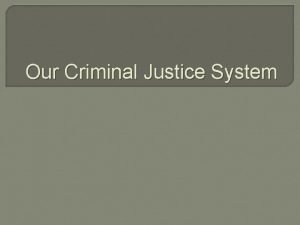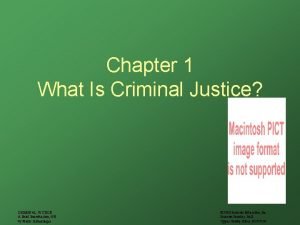Promising Practices in Criminal Justice Reform Council of









- Slides: 9

Promising Practices in Criminal Justice Reform Council of State Government June 2017 Presentation by Steve Allen, CSG


Most people in the justice system have multiple risks and needs Objective Risk Needs Public Safety Public Health • Recidivism • Violence • Relapse • Decompensation • • • Criminal Thinking* Associates Drugs & Alcohol Family & Relationships Work/School Lifestyle Substance Abuse Mental Illness Co-occurring Physical health *Most predictive Council of State Governments Justice Center 3

People with behavioral health conditions are overrepresented in criminal justice systems In the U. S. General Population: In the U. S. State Prison Population: 53% Meet criteria for Substance Abuse Disorders 9% Meet criteria for substance use disorders 16% Meet criteria For mental illness 5% Meet criteria for serious mental illness Source: Doris James and Lauren Glaze. “Mental Health Problems of Prison and Jail Inmates”. September 2006. Office of Justice Programs http: //gainscenter. samhsa. gov/pdfs/disorders/gainsjailprev. pdf 56% Meet criteria for Mental Health Problem 17% Meet criteria for serious mental illness On average, female inmates have a higher prevalence of MH and SU Disorders than male offenders

Properly assessing risks and needs helps appropriately match people to the right types of interventions Risk and Treatment Assessment Risk, need and responsivity principles work by individually matching an individual’s risk of recidivism and criminogenic need factors to programs and treatment. MOD/ HIGH RISK LOW RISK When tailored programs and treatment are combined with community supervision, they are effective in reducing recidivism. Jordan M. Hyatt, JD Ph. D and Geoffrey C. Barnes, Ph. D, Evidence Based Practices (EBP) & Workload Analysis: Survey Results, April 2015 Low to High Treatment Needs Standard Supervision Enhanced Supervision Standard Treatment Enhanced Treatment Council of State Governments Justice Center | 5

To reduce recidivism, approaches must address the need areas that drive criminal behavior Addressing just one need is insufficient to change behavior Programs must be based on proven curricula or principles of effective intervention Addressing only one criminogenic factor has significantly less of an impact than addressing multiple factors Evidenced-based practices significantly reduce recidivism, while outdated punitive approaches can increase negative results Targeting 1 Need Targeting 3+ Needs Cognitivebehavioral with graduated skills practice +8% Programs must have high integrity Program integrity is how closely a program aligns with best practice standards (fidelity to the model). Increased Recidivism 22% Reduced Recidivism 10% Punishment oriented 14% +8% 0 -30 22% 51% Level of Recidivism Reduction § 31 -59 60 -69 70+ Program integrity score -26% Reduced Recidivism Andrews and Bonta, The Psychology of Criminal Conduct, 5 th ed. (New Providence, NJ: Mathew and Bender & Company, Inc. , 2010); Lowenkamp, Latessa, and Holsinger, “The Risk Principle in Action: What Have We Learned from 13, 676 Offenders and 97 Correctional Programs? ” Crime and Delinquency 52, no. 1 (2006): 77 -93. -19% Increased Recidivism Council of State Governments Justice Center | 6

Adherence to RNR principles is especially important to the effectiveness of community supervision as a recidivism reduction strategy EFFECT SIZE OF DIFFERENT SUPERVISION PROGRAMS ON RECIDIVISM REDUCTION AS DETERMINED BY INVENTORY OF EVIDENCE-BASED AND RESEARCH-BASED PROGRAMS FOR ADULT CORRECTIONS AS OF DECEMBER 2013 ($7, 646) Benefits 0. 016 Minus Cost $3, 728 Benefits Minus Cost Intensive Supervision Program Only Intensive Supervision Program + Treatment -0. 205 § Characteristics of Intensive Supervision Programs § Surveillance focus § One size fits all approach § Contact frequency as a key performance measure for officers § Use of incarceration as primary sanction § Proportionality of sanctions not prioritized § Little consideration of criminogenic “needs” Characteristics of RNR Supervision Assessing risk/needs Focusing on higher risk parolees Balancing supervision and treatment Risk Needs Responsivity Supervision $12, 121 Benefits -0. 267 Minus Cost Using incentives and rewards Involving offenders in process Responding to violations in swift and consistent manner -0. 3 -0. 25 -0. 2 -0. 15 -0. 1 -0. 05 0 0. 05 High quality CBI programming Increased Recidivism Reduction § Washington State Institute for Public Policy. Benefit Cost Results: Adult Criminal Justice System. June 2016. http: //wsipp. wa. gov/Benefit. Cost? topic. Id= 2 Council of State Governments Justice Center | 7

Providing funding and engaging community providers in collaborative and evidence-based interventions can reduce incarceration for people with behavioral health needs ARRAY OF COMMUNITY INTERVENTIONS AND SUPPORTS Funding Outpatient Treatment Intensive Outpatient Treatment Certified Peer Supports Aftercare Correctional Programming Network of Providers More diversions from incarceration Case Management Fewer supervision failures Specialized Supervision Self-Help Groups Supported Housing Council of State Governments Justice Center | 8

For more promising practices from around the country, visit the CSG website: https: //csgjusticecenter. org/jr/
 Guelph university criminal justice and public policy
Guelph university criminal justice and public policy Responsibilities and functions of saps
Responsibilities and functions of saps Typologies of crime
Typologies of crime Everyday ethics for the criminal justice professional
Everyday ethics for the criminal justice professional Criminal justice
Criminal justice What is a grass eater in criminal justice
What is a grass eater in criminal justice Unit 2 criminal law and juvenile justice
Unit 2 criminal law and juvenile justice The american system of criminal justice 16th edition
The american system of criminal justice 16th edition The oldest community-based correctional program is
The oldest community-based correctional program is Inaccurate observation in criminal justice
Inaccurate observation in criminal justice

















